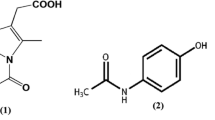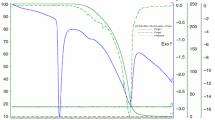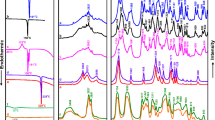ABSTRACT
Purpose
To demonstrate a very effective and easy way of stabilization of amorphous indomethacin (IMC) by preparing binary mixtures with octaacetylmaltose (acMAL). In order to understand the origin of increased stability of amorphous system inter- and intramolecular interactions between IMC and acMAL were studied.
Methods
The amorphous IMC, acMAL and binary mixtures (IMC–acMAL) with different weight ratios were analyzed by using Dielectric Spectroscopy (DS), Differential Scanning Calorimetry (DSC), Raman Spectroscopy, X-ray Diffraction (XRD), Infrared Spectroscopy (FTIR) and Quantitative Structure–Activity Relationship (QSAR).
Results
Our studies have revealed that indomethacin mixed with acetylated saccharide forms homogeneous mixture. Interestingly, even a small amount of modified maltose prevents from recrystallization of amorphous indomethacin. FTIR measurements and QSAR calculations have shown that octaacetylmaltose significantly affects the concentration of indomethacin dimers. Moreover, with increasing the amount of acMAL in the amorphous solid dispersion molecular interactions between matrix and API become more dominant than IMC-IMC ones. Structural investigations with the use of X-ray diffraction technique have demonstrated that binary mixture of indomethacin with acMAL does not recrystallize upon storage at room temperature for more than 1.5 year. Finally, it was shown that acMAL can be used to improve solubility of IMC.
Conclusions
Acetylated derivative of maltose might be very effective agent to improve physical stability of amorphous indomethacin as well as to enhance its solubility. Intermolecular interactions between modified carbohydrate and IMC are likely to be responsible for increased stability effect in the glassy state.












Similar content being viewed by others
REFERENCES
Schuna AA. Update on treatment of rheumatoid arthritis. J Am Pharm Assoc. 1998;38:728–35.
Sweetman SC. Martindale: the complete drug reference. London: Pharmaceutical Press; 2005. p. 47.
Rodriguez LA, Varas C, Patrono C. Differential effects of aspirin and non-aspirin nonsteroidal antiinflammatory drugs in the primary prevention of myocardial infarction in postmenopausal women. Epidemiology. 2000;11:382–7.
Flynn BL, Theesen KA. Pharmacologic management of Alzheimer disease part III: nonsteroidal antiinflammatory drugs–emerging protective evidence? Ann Pharmacother. 1999;33:840–9.
Jones MK, Wang H, Peskar BM, Levin E, Itani RM, Sarfels IJ, et al. Inhibition of angiogenesis by nonsteroidal anti-inflammatory drugs: insight into mechanisms and implications for cancer growth and ulcer healing. Nat Med. 1999;5:1418–23.
Simmons DL, Botting RM, Hla T. Cyclooxygenase isozymes: the biology of prostaglandin synthesis and inhibition. Pharm Rev. 2004;56:387–437.
Weigert G, Berisha F, Resch H, Karl K, Schmetterer L, Garhofer G. Effect of unspecific inhibition of cyclooxygenase by indomethacin on retinal and choroidal blood flow. Invest Ophthalmol Vis Sci. 2008;49:1065–70.
Yamamoto T, Nozaki-Taguchi N. Analysis of the effects of cyclooxygenase (COX)-1 and COX-2 in spinal nociceptive transmission using indomethacin, a non-selective COX inhibitor, and NS-398, a COX-2 selective inhibitor. Brain Res. 1996;739:104–10.
Dressman J, Butler J, Hempenstall J, Reppas C. The BCS: where do we go from here. Pharm Technol. 2001;25:68–76.
Amidon GL, Lennernäs H, Shah VP, Crison JR. A theoretical basis for a biopharmaceutic drug classification: the correlation of in vitro drug product dissolution and in vivo bioavailability. Pharm Res. 1995;12:413–20.
Lobenberg R, Amidon GL. Modern bioavailability, bioequivalence and biopharmaceutics classification system; new scientific approaches to international regulatory standards. Eur J Pharm Biopharm. 2000;50:3–12.
Ford JL. The current status of solid dispersions. Pharm Acta Helv. 1986;61:69–88.
Hancock BC, Zografi G. Characteristics and significance of the amorphous state in pharmaceutical systems. J Pharm Sci. 1997;86:1–12.
Martin A. Physical pharmacy. 4th ed. Philadelphia: Lea and Febiger; 1993.
Kaminski K, Kaminska E, Adrjanowicz K, Grzybowska K, Wlodarczyk P, Paluch M, et al. Dielectric relaxation studies on Tramadol monohydrate and its hydrochloride salt. J Pharm Sci. 2010;99:94–106.
Adrjanowicz K, Kaminski K, Paluch M, Wlodarczyk P, Grzybowska K, Wojnarowska Z, et al. Dielectric relaxation studies and dissolution behavior of amorphous verapamil hydrochloride. J Pharm Sci. 2010;99:828–39.
Hancock BC, Parks M. What is the true solubility advantage for amorphous pharmaceuticals. Pharm Res. 2000;17:393–414.
Taylor LS, Zografi G. Spectroscopic characterization of interactions between PVP and indomethacin in amorphous molecular dispersions. Pharm Res. 1997;14:1691–8.
Adrjanowicz K, Zakowiecki D, Kaminski K, Hawelek L, Grzybowska K, Tarnacka M, et al. Molecular dynamics in supercooled liquid and glassy states of antibiotics: azithromycin, clarithromycin and roxithromycin studied by dielectric spectroscopy. Advantages given by the amorphous state. Mol Pharm. 2012;9:1748–63.
Serajuddin AT. Solid dispersion of poorly water-soluble drugs: early promises, subsequent problems, and recent breakthroughs. J Pharm Sci. 1999;88:1058–66.
Leuner C, Dressman J. Improving drug solubility for oraldelivery using solid dispersions. Eur J Pharm Biopharm. 2000;50:47–60.
Valizadeh H, Nokhodchi A, Qarakhani N, Zakeri-Milani P, Azarmi S, Hassanzadeh D, et al. Physicochemical characterization of solid dispersions of indomethacin with PEG 6000, Myrj 52, lactose, sorbitol, dextrin, and Eudragit E100. Drug Dev Ind Pharm. 2004;30:303–17.
Jung MS, Kim JS, Kim MS, Alhalaweh A, Cho W, Hwang SJ, et al. Bioavailability of indomethacin-saccharin cocrystals. J Pharm Pharmacol. 2010;62:1560–8.
Sato T, Okada A, Sdekiguchi K, Tsuda Y. Differences in physicopharmaceutical properties between crystalline and noncrystalline 9,3’diacetylmidecamycin. Chem Pharm Bull. 1981;29:2675–82.
Fukuoka E, Makita M, Yamamura S. Some physicochemical properties of glassy indomethacin. Chem Pharm Bull. 1986;34:4314–21.
Bhardwaj SP, Suryanarayanan R. Molecular mobility as an effective predictor of the physical stability of amorphous trehalose. Mol Pharm. 2012;9:3209–17.
Corrigan OI, Holohan EM, Sabra K. Amorphous forms of thiazide diuretics prepared by spray-drying. Int J Pharm. 1984;18:195–200.
Craig DQM, Royall PG, Kett VL, Hoptopn ML. The relevance of the amorphous state to pharmaceutical dosage forms: glassy drugs and freeze dried systems. Int J Pharm. 1999;179:179–207.
Adrjanowicz K, Kaminski K, Grzybowska K, Hawelek L, Paluch M, Gruszka I, et al. Effect of cryogrinding on chemical stability of the sparingly water-soluble drug furosemide. Pharm Res. 2011;28:3220–36.
Hedoux A, Guinet Y, Capet F, Paccou L, Decamps M. Evidence for a high-density amorphous form in indomethacin from Raman scattering investigations. Phys Rev B. 2008;77:094205.
Wojnarowska Z, Adrjanowicz K, Wlodarczyk P, Kaminska E, Kaminski K, Grzybowska K, et al. Broadband dielectric relaxation study at ambient and elevated pressure of molecular dynamics of pharmaceutical: indomethacin. J Phys Chem B. 2009;113:12536.
Dawsona KJ, Kearns KL, Lian Y, Steffenc W, Ediger MD. Physical vapor deposition as a route to hidden amorphous states. Proc Natl Acad Sci U S A. 2009;106:15165–70.
Kearns KL, Swallen SF, Ediger MD, Wu T, Yu L. Influence of substrate temperature on the stability of glasses prepared by vapor deposition. J Chem Phys. 2007;127:154702.
Kearns KL, Swallen SF, Ediger MD, Sun Y, Yu L. Calorimetric evidence for two distinct molecular packing arrangements in stable glasses of indomethacin. J Phys Chem B. 2009;113:1579–86.
Babu NJ, Nangia A. Solubility advantage of amorphous drugs and pharmaceutical cocrystals. Cryst Growth Des. 2011;11:2662–79.
Murdande SB, Pikal MJ, Shanker RM, Bogner RH. Solubility advantage of amorphous pharmaceuticals: II. Application of quantitative thermodynamic relationships for prediction of solubility enhancement in structurally diverse insoluble pharmaceuticals. Pharm Res. 2010;27:2704–14.
Karmwar P, Graeser K, Gordon KC, Strachan CJ, Rades T. Effect of different preparation methods on the dissolution behaviour of amorphous indomethacin. Eur J Pharm Biopharm. 2012;80:459–64.
Pikal MJ, Lukes AL, Lang JE, Gaines K. Quantitative crystallinity determinations for beta-lactam antibiotics by solution calorimetry: correlations with stability. J Pharm Sci. 1978;67:767.
Hancock BC, Carlson GT, Ladipo DD, Langdon BA, Mullarney MP. Comparison of the mechanical properties of the crystalline and amorphous forms of a drug substance. Int J Pharm. 2002;241:73–85.
Yoshioka M, Hancock BC, Zografi G. Crystallization of indomethacin from the amorphous state below and above its glass transition temperature. J Pharm Sci. 1994;83:1700–5.
Shamblin SL, Hancock BC, Pikal MJ. Coupling between chemical reactivity and structural relaxation in pharmaceutical glasses. Pharm Res. 2006;23:2254–68.
Wojnarowska Z, Grzybowska K, Adrjanowicz K, Kaminski K, Paluch M, Hawelek L, et al. Study of the amorphous glibenclamide drug: analysis of the molecular dynamics of quenched and cryomilled material. Mol Pharm. 2010;7:1692–707.
Hancock BC, Shamblin SL, Zografi G. Molecular mobility of amorphous pharmaceutical solids below their glass transition temperatures. Pharm Res. 1995;1:799–806.
Tian W, Lian Y. Origin of enhanced crystal growth kinetics near Tg probed with indomethacin polymorphs. J Phys Chem B. 2006;110:15694–9.
Hancock BC, Shamblin SL. Molecular mobility of amorphous pharmaceuticals determined using differential scanning calorimetry. Thermochim Acta. 2001;380:95.
Vyazovkin S, Dranca I. Effect of physical aging on nucleation of amorphous indomethacin. J Phys Chem B. 2007;111:7283–7.
Shamblin SL, Tang X, Chang L, Hancock BC, Pikal MJ. Characterization of the time scales of molecular motion in pharmaceutically important glasses. J Phys Chem B. 1999;103:4113.
Hancock BC, Dupuis Y, Thibert R. Determination of the viscosity of an amorphous drug using thermomechanical analysis (TMA). Pharm Res. 1999;16:672.
DeGusseme A, Carpentier L, Willart JF, Descamps M. Molecular mobility in supercooled trehalose. J Phys Chem B. 2003;107:10879–86.
He R, Craig DQM. An investigation into the thermal behaviour of an amorphous drug using low frequency dielectric spectroscopy and modulated. J Pharm Pharmacol. 2001;53:41.
Carpentier L, Decressain R, Desprez S, Descamps M. Dynamics of the amorphous and crystalline alpha-, gamma-phases of indomethacin. J Phys Chem B. 2006;110:457–64.
Bhugra C, Shmeis R, Krill SL, Pikal MJ. Different measures of molecular mobility: comparison between calorimetric and thermally stimulated current relaxation times below Tg and correlation with dielectric relaxation times above Tg. J Pharm Sci. 2008;97:4498–515.
Correia NT, Moura Ramos JJ, Descamps M, Collins G. Molecular mobility and fragility in indomethacin: a thermally stimulated depolarisation currents study. Pharm Res. 2001;18:1767–74.
Moura Ramos JJ, Correia NT, Taveira-Marques R, Collins G. The activation energy at Tg and the fragility index of indomethacin, predicted from the influence of the heating rate on the temperature positron and on the intensity of the thermally stimulated depolarisation current peak. Pharm Res. 2002;19:1879–84.
Savolainen M, Heinz A, Strachan C, Gordon KC, Yliruusi J, Rades T, et al. Screening for differences in the amorphous state of indomethacin using multivariate visualization. Eur J Pharm Sci. 2007;30:113–23.
Crowley KJ, Zografi G. Cryogenic grinding of indomethacin polymorphs and solvates: assessment of amorphous phase formation and amorphous phase physical stability. J Pharm Sci. 2002;91:492–507.
Planinsek O, Zadnik J, Kunaver M, Srcic S, Godec A. Structural evolution of indomethacin particles upon milling: time-resolved quantification and localization of disordered structure studied by IGC and DSC. J Pharm Sci. 2010;99:1968–81.
Greco K, Bogner R. Crystallization of amorphous indomethacin during dissolution: effect of processing and annealing. Mol Pharm. 2010;7:1406–18.
Karmwar P, Graeser K, Gordon KC, Strachan CJ, Rades T. Investigation of properties and recrystallisation behaviour of amorphous indomethacin samples prepared by different methods. Int J Pharm. 2011;417:94–100.
Bates S, Zografi G, Engers D, Morris K, Crowley K, Newman A. Analysis of amorphous and nanocrystalline solids from their x-ray diffraction patterns. Pharm Res. 2006;23:2333–49.
Dalal SS, Ediger MD. Molecular orientation in stable glasses of indomethacin. J Phys Chem Lett. 2012;3:1229–33.
Tetsumi I, Uekama K. Pharmaceutical applications of cyclodextrins. III. Toxicological issues and safety evaluation. J Pharm Sci. 1997;86:147–62.
Lofsson T, Masson M. Cyclodextrins in topical drug formulations: theory and practice. Int J Pharm. 2001;22:15–30.
Lakshman JP, Cao Y, Kowalski J, Serajuddin AT. Application of melt extrusion in the development of a physically and chemically stable high-energy amorphous solid dispersion of a poorly water-soluble drug. Mol Pharm. 2008;5:994–1002.
Kaushal AM, Gupta P, Bansal AK. Amorphous drug delivery systems: molecular aspects, design and performance. Crit Rev Ther Drug Carrier Syst. 2004;21:133–93.
Van den Mooter G, Wuyts M, Blaton N, Busson R, Grobet P, Augustijns P, et al. Physical stabilisation of amorphous ketoconazole in solid dispersions with polyvinylpyrrolidone K25. Eur J Pharm Sci. 2001;12:261–9.
Wang X, de Armas HN, Blaton N, Michoel A, Van den Mooter G. Phase characterization of indomethacin in binary solid dispersions with PVP VA64 or Myrj 52. Int J Pharm. 2007;345:95–100.
Khodaverdi E, Khalili N, Zangiabadi F, Homayouni A. Preparation, characterization and stability studies of glassy solid dispersions of indomethacin using PVP and isomalt as carriers. Iran J Basic Med Sci. 2012;15:820–32.
Backensfeld T, Müller BW, Wiese M, Seydel JK. Effect of cyclodextrin derivatives on indomethacin stability in aqueous solution. Pharm Res. 1990;7:484–90.
Bogdanova S, Bontcheva E, Avramova N. Phase characterization of indomethacin in adsorbates onto hydroxyethylcellulose. Drug Dev Ind Pharm. 2007;33:900–6.
Ghanem AH, El-Sabbagh H, Abdel-Alim H. Stability of indomethacin solubilized system. Pharmazie. 1979;34:406–7.
Shamblin SL. The characteristics of sucrose-polymer mixtures in the amorphous state. Ph. D. Dissertation, The University of Wisconsins Madison, 1997.
Grzybowska K, Kaminski K, Paluch M, Hawelek L. Patent application “The composite based on celecoxib and method of formulation”, date of application: 19.04.2011 r., No. of application: P.394614.
Grzybowska K, Paluch M, Wlodarczyk P, Grzybowski A, Kaminski K, Hawelek L, et al. Enhancement of amorphous celecoxib stability by mixing it with octaacetylmaltose: the molecular dynamics study. Mol Pharm. 2012;9:894–904.
Kaminska E, Adrjanowicz K, Kaminski K, Wlodarczyk P, Hawelek L, Kolodziejczyk K, et al. A new way of stabilization of furosemide upon cryogenic grinding by using acylated saccharides matrices. The role of hydrogen bonds in decomposition mechanism. Mol Pharm. 2013;10:1824–35.
Becke AD. Density-functional thermochemistry. III. The role of exact exchange. J Chem Phys. 1993;98:5648–52.
Parr RG, Yang W. Density-functional theory of the electronic structure of molecules. Annu Rev Phys Chem. 1995;46:701–28.
Lee C, Yang W, Parr RG. Development of the Colle-Salvetti correlation-energy formula into a functional of the electron density. Phys Rev B. 1988;37:785–9.
Hehre WJ, Radom L, Schleyer PR, Pople JA. Ab initio molecular orbital theory. New York: Wiley; 1986. p. 20–9. 65–88.
Parr RG, Yang W. Density functional theory of atoms and molecules. New York: Oxford University Press; 1989. p. 142–97.
Burke K, Perdew JP, Wang Y. In: Dobson JF, Vignale G, Das MP, editors. Electronic density functional theory: recent progress and new directions. New York: Plenum; 1998.
Frisch MJ, Trucks GW, Schlegel HB, Scuseria GE, Robb MA, Cheeseman JR, et al. Gaussian 03W, Revision B. 05, Gaussian Inc., Pittsburgh PA, 2003.
Mahieu A, Willart JF, Dudognon E, Danède F, Descamps M. A new protocol to determine the solubility of drugs into polymer matrixes. Mol Pharm. 2013;10:560–6.
Kaminski K, Wlodarczyk P, Havelek L, Adrjanowicz K, Wojnarowska Z, Paluch M, et al. Comparative dielectric studies on two hydrogen-bonded and van der Waals liquids. Phys Rev E. 2011;83:061506.
Blochowicz T, Rössler EA. Beta relaxation versus high frequency wing in the dielectric spectra of a binary molecular glass former. Phys Rev Lett. 2004;92:225701.
Roland CM, Ngai KL. Segmental relaxation and the correlation of time and temperature dependencies in poly (vinyl methyl ether)/polystyrene mixtures. Macromolecules. 1992;25:363–7. Dynamical heterogeneity in a miscible polymer blend. Macromolecules. 1991;24:2261–5.
Capaccioli S, Kessairi K, Prevosto D, Lucchesi M, Ngai KL. Genuine Johari–Goldstein β-relaxations in glass-forming binary mixtures. J Non-Cryst Solids. 2006;352:4643–8.
Capaccioli S, Prevosto D, Kessairi K, Lucchesi M, Rolla P. Relation between the dispersion of α-relaxation and the time scale of β-relaxation at the glass transition. J Non-Cryst Solids. 2007;353:3984–8.
Kessairi K, Capaccioli S, Prevosto D, Lucchesi M, Rolla PA. Relaxation dynamics in tert-butylpyridine/tristyrene mixture investigated by broadband dielectric spectroscopy. J Chem Phys. 2007;127:174502.
Kessairi K, Capaccioli S, Prevosto D, Sharifi S, Rolla PA. Effect of temperature and pressure on the structural (α-) and the true Johari–Goldstein (β-) relaxation in binary mixtures. J Non-Cryst Solids. 2007;353:4273–7.
Power G, Vij JK, Johari GP. Relaxations and nano-phase-separation in ultraviscous heptanol-alkyl halide mixture. J Chem Phys. 2007;126:034512.
Kremer F, Schönhals A (eds). Broadband dielectric spectroscopy. Springer-Verlag, 2003, ISBN 978-3-540-43407-8.
Williams G, Watts DC. Non-symmetrical dielectric relaxation behavior arising from a simple empirical decay function. Trans Faraday Soc. 1970;66:80–5.
Kohlrausch R. Nachtrag uber die elastiche Nachwirkung beim Cocon und Glasladen. Ann Phys Leipzig. 1847;72:353–405.
Alvarez F, Alegria A, Colmenero J. Relationship between the time-domain Kohlrausch-Williams-Watts and frequency-domain Havriliak-Negami relaxation functions. Phys Rev B. 1991;44:7306–12.
Vyazovkin S, Dranca I. Physical stability and relaxation of amorphous indomethacin. J Phys Chem B. 2007;111:7283–7.
Strachan CJ, Rades T, Gordon KC. A theoretical and spectroscopic study of γ-crystalline and amorphous indomethacin. J Pharm Pharmacol. 2007;59:261–9.
Havriliak S, Negami S. A complex plane analysis of α- dispersions in some polymer systems. J Polym Sci C. 1966;14:99–117.
Vogel H. Das Temperaturabhangigkeitgesetz der Viskosität von Flüssigkeiten. J Phys Z. 1921;22:645–6.
Fulcher GS. Analysis of recent measurements of the viscosity of glasses. J Am Ceram Soc. 1925;8:339–55.
Tammann G, Hesse W. Die Abhängigkeit der Viscosität von der Temperatur bie unterkühlten Flüssigkeiten. Z Anorg Allg Chem. 1926;156:245–57.
Gordon M, Taylor JS. Ideal copolymers and the second-order transitions of synthetic rubbers. I. Non-crystalline copolymers. J Appl Chem. 1952;2:493–500.
Simha R, Boyer RF. On a general relation involving the glass temperature and coefficients of expansion of polymers. J Chem Phys. 1962;37:1003–7.
Couchman PR, Karasz FE. A classical thermodynamic discussion on the effect of composition on glass-transition temperatures. Macromolecules. 1978;11:117–9.
Angell CA. Relaxation in liquids, polymers and plastic crystals — strong/fragile patterns and problems. J Non-Cryst Solids. 1991;131–133:13–31.
Kirstenmacher TJ, Marsh RE. Crystal and molecular structure of an antiinflammatory agent, indomethacin, 1-(p-chlorobenzoyl)-5-methoxy-2-methylindole-3-acetic acid. J Am Chem Soc. 1972;94:1340–5.
ACKNOWLEDGMENTS AND DISCLOSURES
E.K., M.T., M.D. are thankful for the financial support from the National Center of Science based on decision DEC-2013/09/D/NZ7/04194. The authors are also thankful to Dr. M. Kopras from GlaxoSmithKline Pharmaceuticals S.A. (Poznan, Poland) for providing indomethacin. We would like to thank Dr M. Jarek from NanoBioMedical Centre (Poznan, Poland) for performing DSC measurements.
This research was supported in part by PL-Grid Infrastructure.
Author information
Authors and Affiliations
Corresponding author
Rights and permissions
About this article
Cite this article
Kaminska, E., Adrjanowicz, K., Zakowiecki, D. et al. Enhancement of the Physical Stability of Amorphous Indomethacin by Mixing it with Octaacetylmaltose. Inter and Intra Molecular Studies. Pharm Res 31, 2887–2903 (2014). https://doi.org/10.1007/s11095-014-1385-4
Received:
Accepted:
Published:
Issue Date:
DOI: https://doi.org/10.1007/s11095-014-1385-4




